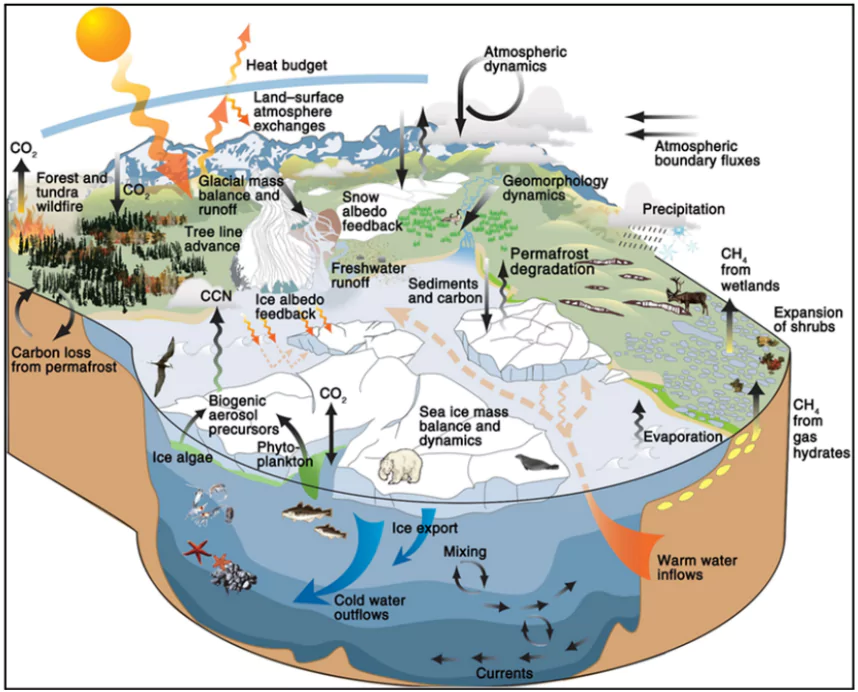According to a new study published in Nature Climate Change, the increasing ferocity of wildfires means that the Arctic Boreal Zone, once a significant carbon sink, is now experiencing a major shift, with over 30% of the region turning into a carbon source.
About Wildfires
- Wildfires are large, uncontrolled fires that rapidly spread across vegetation, forests, and grasslands, often fueled by dry conditions, wind, and high temperatures.
- Wildfires release significant amounts of carbon dioxide into the atmosphere, disrupt ecosystems, destroy habitats, and contribute to a dangerous feedback loop that accelerates global warming.
What is Carbon Sink?
- Carbon Sink is a natural or artificial reservoir that absorbs and stores more carbon dioxide (CO₂) from the atmosphere than it releases.
- Function: It helps in reducing the concentration of greenhouse gases, mitigating climate change effects.
- Examples: Forests, oceans, and soil are major natural carbon sinks, while technologies like carbon capture and storage (CCS) represent artificial sinks.
|
Global Trend of Wildfires
- Wildfires worldwide are becoming more frequent and intense, driven by worsening climate conditions.
- Recent Wildfire Events
-
- The Eaton and Palisades fires in California destroyed more than 14,000 structures and scorched approximately 16,000 hectares of land.
- In February 2025, a major wildfire near Ofunato city in Japan burned nearly 2,900 hectares, damaged around 210 buildings, and displaced over 4,200 residents.
- According to the Copernicus Air Monitoring Service (CAMS), wildfires released 800,000 tonnes of carbon globally in January 2025, nearly four times more than the same period a decade ago.
- Data from NASA’s Terra and Aqua satellites revealed that the heat radiated from fires in early 2025 exceeded the 2003–2024 average by an entire order of magnitude.
- In India, states like Uttarakhand, Odisha, and Chhattisgarh recorded the most wildfires in 2024, although the number of fire hotspots nationwide is slightly declining.
Factors Contributing to Rising Wildfire Incidents
- Rising Temperatures: Rising temperature is making the atmosphere and vegetation drier making them more susceptible to fire.
- Rising land temperatures in India’s northwest, northeast, and central regions are accelerating by 0.1º–0.4º C per decade, increasing wildfire risks.
- Changing Heatwave Patterns : Heatwaves are occurring earlier, moving slower, and lasting longer, creating ideal conditions for wildfires.
- For Example; On an average, heat waves have slowed down nearly 8 km/day each decade and lasted longer by about four days , the effects being particularly drastic in North America and Eurasia.
- Heat waves have also increased in frequency, from about 75 events averaged over 1979-1983 to about 98 over 2016-2020.
- Dry Spells: Prolonged dry spells due to climate change are drying out soil and vegetation, making forests more flammable.
- Carbon Emissions from Forest Fires: Forest fires in India alone emit around 69 million tonnes of carbon dioxide every year, further aggravating global warming.
About Arctic Boreal Zone
- The Arctic Boreal Zone, located along the Arctic Circle, is the vast northern ecosystem that spans across 26 million square kilometers, including:
- Tundra (treeless regions)
- Boreal forests (taiga)
- Wetlands
- It is found primarily in regions like Alaska, Canada, Northern Europe, and Siberia.
- Indigenous communities in the Arctic Boreal Zone.
- Inuit: The most widespread Arctic coastal people, living from Arctic Russia to Canada to Greenland. The word “Inuit” means “the people” in the Inuit language of Inuktut.
- Saami: Live in the circumpolar areas of Finland, Sweden, Norway, and Northwest Russia.
- Aleut: Also known as Unangan, lives in Alaska.
- Yupik: Also known as Yupiit, lives in Alaska.
Climate Characteristics
- The region experiences extreme cold with long, harsh winters and short summers.
- Permafrost (frozen ground) is a defining feature, remaining below 0°C for at least two consecutive years.
- Short growing season with limited sunlight for vegetation growth, especially in the tundra areas.
 Cold-adapted species such as reindeer, Arctic foxes, and various migratory bird species inhabit the region.
Cold-adapted species such as reindeer, Arctic foxes, and various migratory bird species inhabit the region.- Role as a Carbon Sink: Historically, the Arctic Boreal Zone has acted as a carbon sink, meaning it absorbed more carbon than it emitted.
- It is known for being soil organic carbon reservoirs.
- This role was due to:
- The presence of vast areas of forests and wetlands that sequester carbon through vegetation and soil.
- Permafrost, which locks up vast amounts of carbon and organic matter.
Transformation of the Arctic Boreal Zone (ABZ)
- Sink to Source: While the Arctic Boreal Zone (ABZ) absorbed carbon from 2001 to 2020, one-third of the zone has been releasing carbon dioxide since 2020.
- Alaska accounts for 44% of the newly detected carbon emissions from the ABZ.
- Northern Europe and Siberia contribute 25% and 13%, respectively, to the region’s carbon emissions.
- Factors contributing to the Transformation
- Thawing tundra permafrost, driven by global warming, is releasing large amounts of carbon dioxide as the soil warms and organic matter decomposes.
- Increased wildfire activity in the Arctic is burning through natural carbon reservoirs, releasing even more carbon and accelerating warming.
- Feedback loop: Wildfires release carbon, which contributes to global warming, creating hotter, drier conditions that lead to more wildfires forming a destructive feedback loop.
- Events like the Eastern Siberia fires in 2003 and the Timmins wildfire in 2012 have significantly contributed to this shift by releasing massive amounts of carbon.
- The 2024 Arctic Report Card by NOAA supports these findings, stating that the Arctic tundra is now a net source of carbon emissions.
![]() 10 Apr 2025
10 Apr 2025

 Cold-adapted species such as reindeer, Arctic foxes, and various migratory bird species inhabit the region.
Cold-adapted species such as reindeer, Arctic foxes, and various migratory bird species inhabit the region.